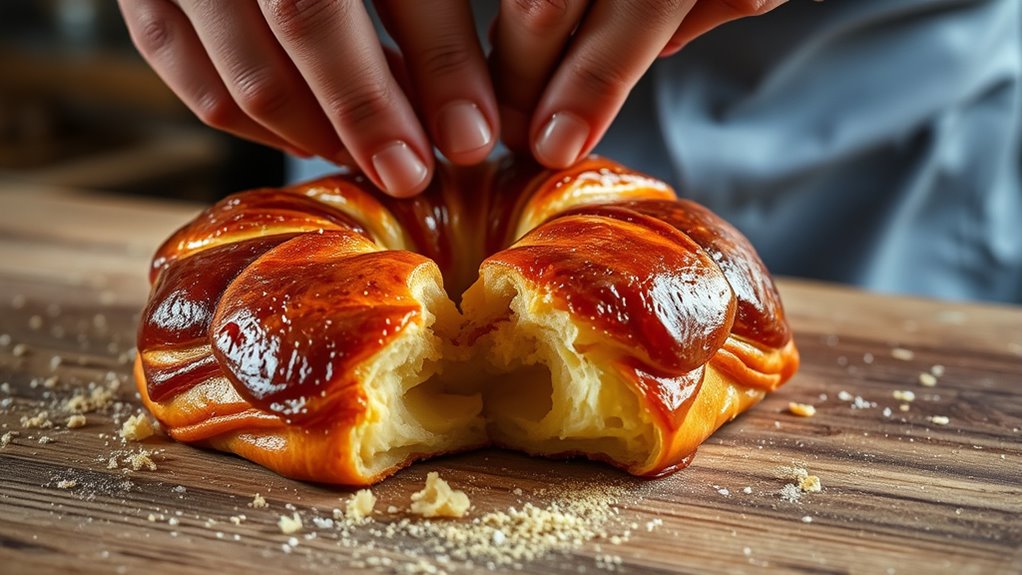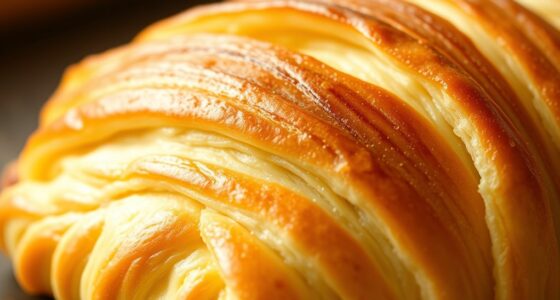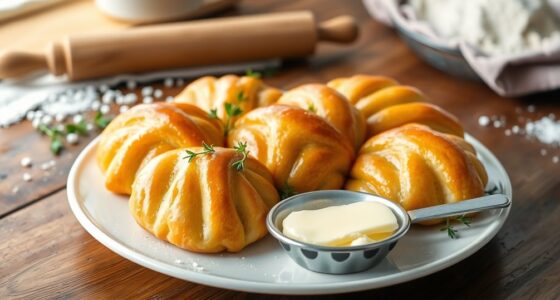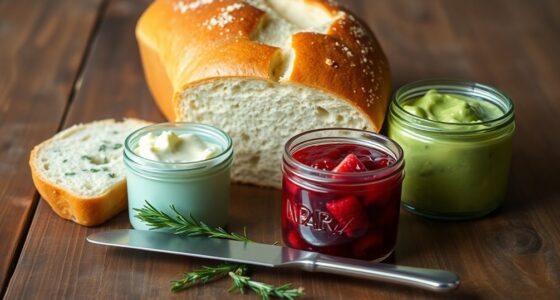To fix a collapsed Kouign‑Amann, focus on your butter handling—don’t skimp on butter during lamination, and guarantee it’s cold but pliable. Apply butter evenly without overworking the dough, and always chill thoroughly before baking to prevent layers from collapsing. Pay attention to accurate butter measurements and maintain consistent oven temperature. Small adjustments like proper layering and temperature control make a big difference—if you keep practicing, you’ll uncover more tips for perfect results.
Key Takeaways
- Ensure adequate, evenly spread butter during lamination to prevent dense, collapsed pastries.
- Use cold, pliable butter around 40°F (4°C) to maintain layer integrity and prevent tearing.
- Avoid overworking the dough and butter layers to preserve elasticity and prevent collapse.
- Chill the dough properly before baking to firm up layers and promote even oven rise.
- Maintain consistent oven temperature and humidity to support proper expansion and flaky texture.
Using Too Little Butter During Lamination

If you don’t use enough butter during lamination, your kouign-amann is likely to collapse or become dense. Butter plays a vital role in developing the signature butter flavor and maintaining dough elasticity. Without sufficient butter, the layers won’t create the flaky, tender texture that defines this pastry. Instead, you’ll end up with a dense, heavy result that lacks the delicate crunch and richness you’re aiming for. Proper butter incorporation ensures the dough remains pliable enough to handle multiple folds and turns, creating those thin, distinct layers. Skimping on butter compromises both flavor and structure, making it hard for the pastry to rise properly and stay airy during baking. To avoid this, always make certain your butter is ample and evenly distributed during lamination.
Incorporating Cold or Hard Butter
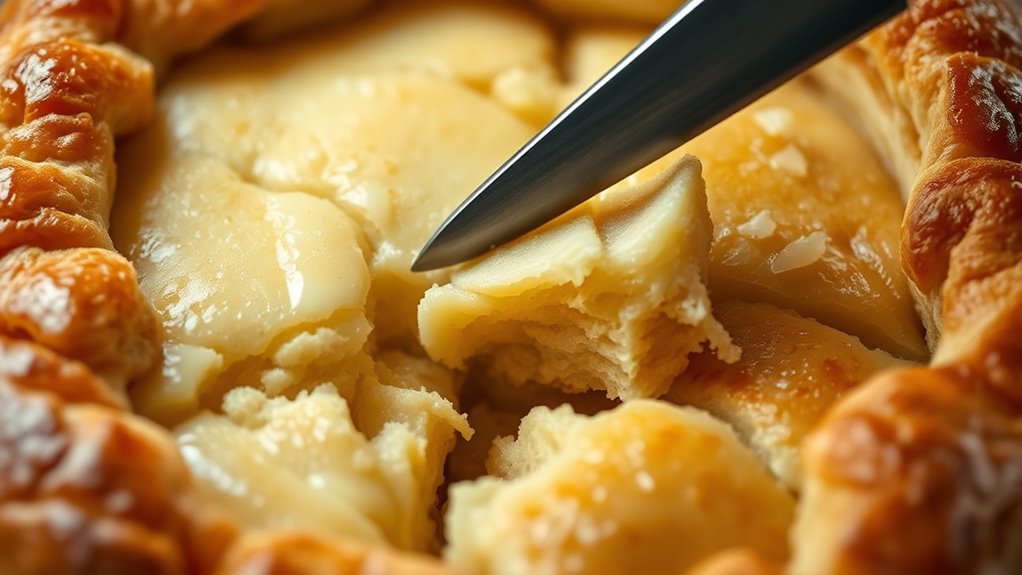
Incorporating cold or hard butter into your dough is essential for achieving the perfect lamination. Proper butter temperature and consistency ensure even layers and prevent tearing. Cold butter, ideally around 40°F (4°C), maintains its shape during rolling and folding, creating distinct layers. Hard butter resists spreading and blending, which helps maintain structure. To visualize, consider this table:
| Butter Temperature | Butter Consistency | Best Use |
|---|---|---|
| 35-40°F (1.5-4°C) | Firm but pliable | Layering and lamination |
| Slightly colder | Very firm | Handling during folding |
| Slightly warmer | Softening | Not recommended for lamination |
| Room temperature | Melty | Avoid for lamination |
Choosing the right butter temperature and consistency is key to preventing collapsed layers. Additionally, understanding the importance of proper butter handling can significantly improve your baking results.
Overworking the Dough and Butter Layers
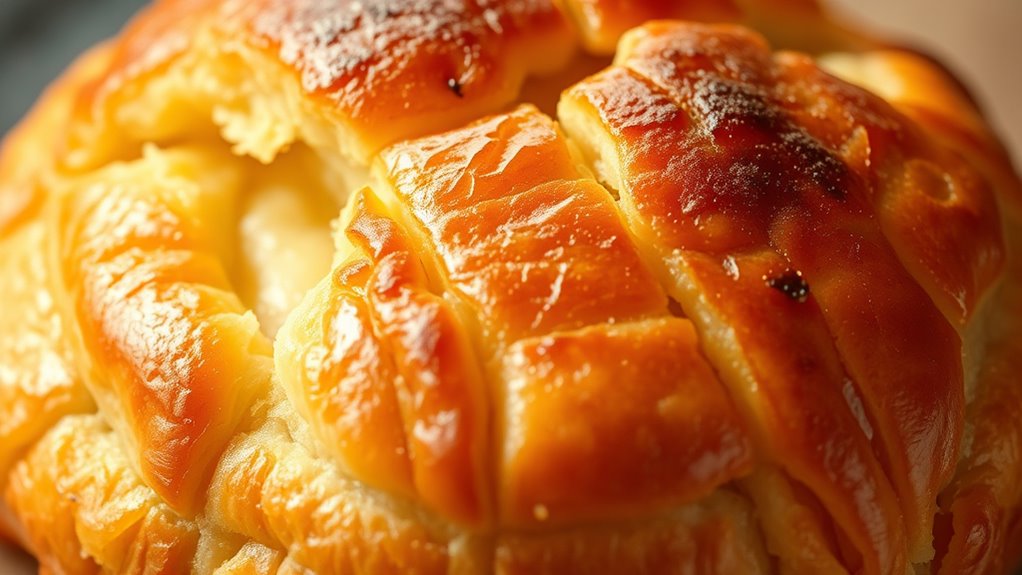
Overworking the dough and butter layers can quickly ruin the delicate structure needed for a perfect Kouign-Amann. When you knead or roll too much, you risk disrupting the butter distribution, leading to uneven layers and a dense crumb. Overworking also decreases dough elasticity, making it harder to create the thin, flaky layers that define this pastry. If the dough becomes tough or overly mixed, the layers won’t expand properly during baking, causing collapse or deflation. To avoid this, handle the dough gently and limit the number of folds. Keep your butter layers intact by working quickly and with minimal force. Properly managing this step ensures that the butter remains evenly distributed, and the dough stays elastic enough to produce a light, airy Kouign-Amann. Handling the dough carefully is essential for maintaining the delicate balance necessary for a perfect bake.
Not Properly Chilling the Dough Before Baking
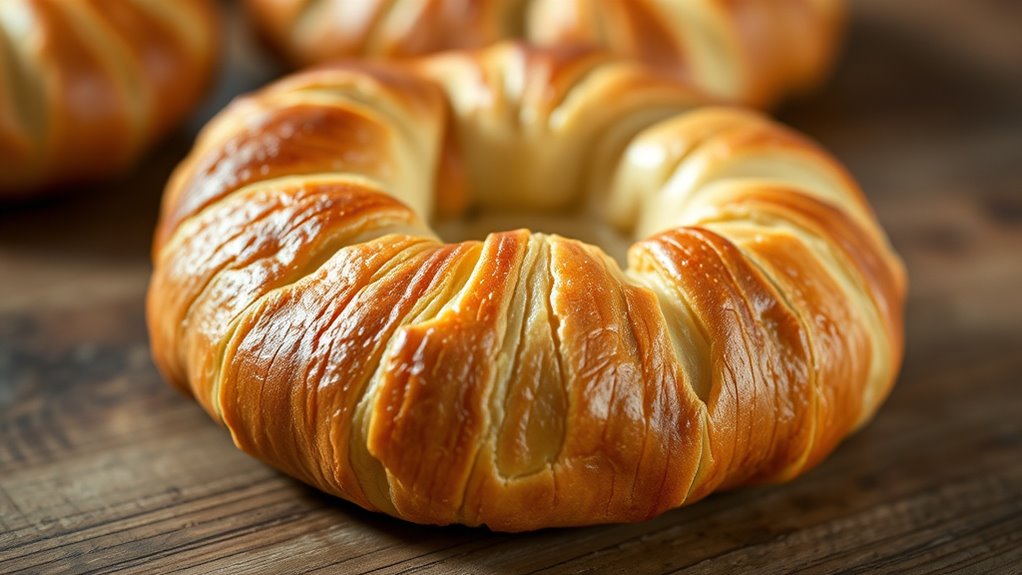
If you skip or rush the chilling step, your dough won’t have enough structure to hold its shape during baking. Rushing into the oven at a high temperature can cause the Kouign-Amann to collapse or spread out. Make sure to give your dough enough time to rest in the fridge before baking for the best results. Proper dough preparation is essential for achieving the ideal flaky layers and stability.
Insufficient Cold Rest Time
One common mistake that leads to a collapsed Kouign-Amann is not giving the dough enough time to chill properly before baking. Without sufficient cold rest, the dough remains too warm, preventing proper dough relaxation. This can cause the butter layers to soften prematurely, leading to a failure to hold their shape during baking. Allowing adequate cold rest ensures the dough firms up, making it easier to handle and shaping more reliable. It also helps the butter layers stay distinct, which is vital for that flaky, layered texture. Rushing this step can result in a dense, flattened pastry instead of the airy, layered Kouign-Amann you’re aiming for. Patience with cold rest is key to maintaining structure and achieving the perfect rise. Incorporating good lighting techniques can also help monitor the dough’s temperature to ensure optimal chilling conditions.
Rapid Baking Temperature
Baking Kouign-Amann at too high a temperature or starting with a hot oven can cause the butter layers to melt rapidly, resulting in a collapse or uneven rise. If your oven preheats too aggressively, the exterior browns before the interior has set, making the butter melt prematurely. This weakens the dough’s structure, preventing proper puffing and leading to flattening. To avoid this, set your oven to a moderate temperature and give it enough time to preheat evenly. It’s vital that the butter stays solid during baking, creating steam and lift. Rushing the process or using an overly hot oven sabotages these layers, causing the Kouign-Amann to lose its shape. Proper oven preheating ensures the butter melts gradually, supporting a perfect rise. Consistent baking temperatures help maintain the integrity of the butter layers throughout the baking process.
Applying Uneven Butter Layers
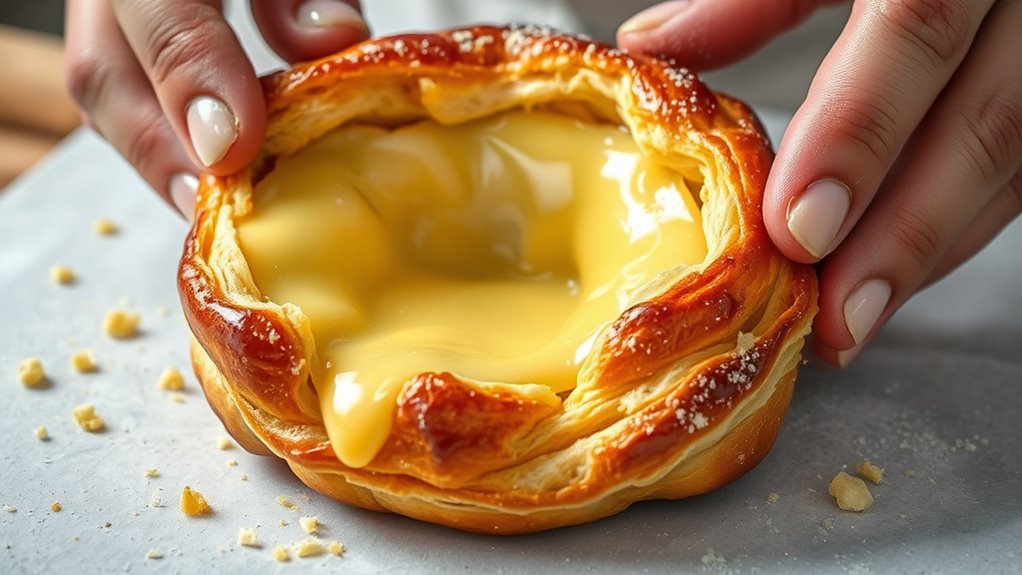
Have you ever wondered how uneven butter layers can actually improve your Kouign-Amann? By intentionally applying uneven butter, you create pockets that enhance butter flavor and promote dough elasticity. This technique encourages diverse layers, resulting in a more complex texture. To visualize, consider this table:
| Layer Type | Effect |
|---|---|
| Thin areas | Crispy edges, intensified butter flavor |
| Thick areas | Fluffy interior, improved dough elasticity |
Mixing butter unevenly allows some sections to absorb more flavor while others remain lighter. This variation helps prevent collapse by strengthening the dough’s structure. When you manipulate butter layers thoughtfully, you’re not just adding richness—you’re also fostering the structural integrity needed for a perfect Kouign-Amann.
Rushing the Folding Process
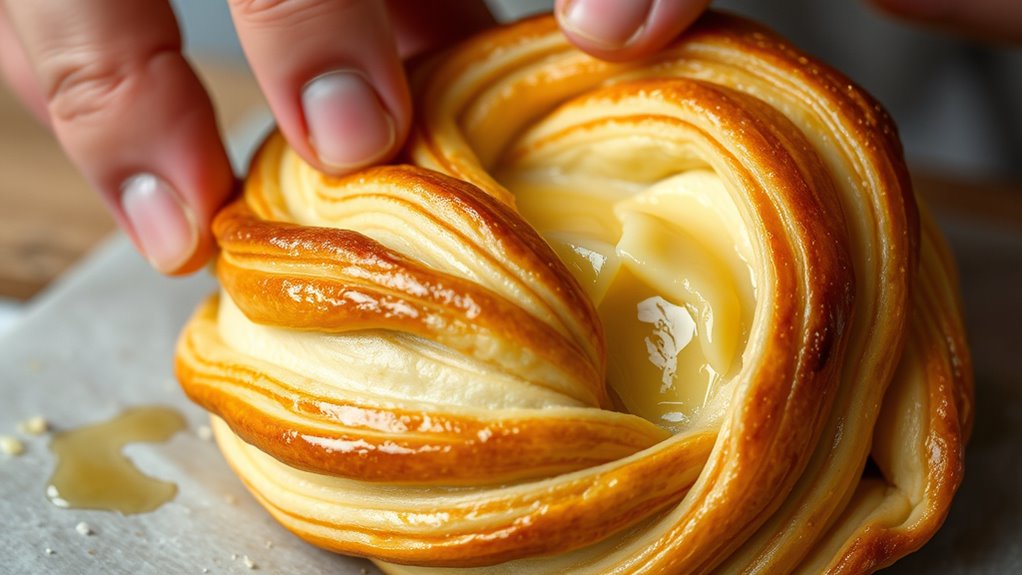
Rushing the folding process can undermine the Kouign-Amann’s delicate structure, leading to uneven layers and a dense, crumbly texture. When you hurry, you might not give the dough enough time to develop proper dough hydration, which is essential for flexibility and strength. High-quality butter melts smoothly into the dough, but if you rush, it can leak out or create uneven distribution, causing layer collapse. Take your time to fold carefully and methodically, ensuring the butter remains well incorporated. Proper dough hydration helps keep the layers moist and pliable, preventing tearing or collapsing during folding. Consistent technique is crucial to building the delicate, flaky structure that makes Kouign-Amann so irresistible, rather than risking a flat or dense pastry from hasty handling.
Misjudging the Butter Quantity for Layers
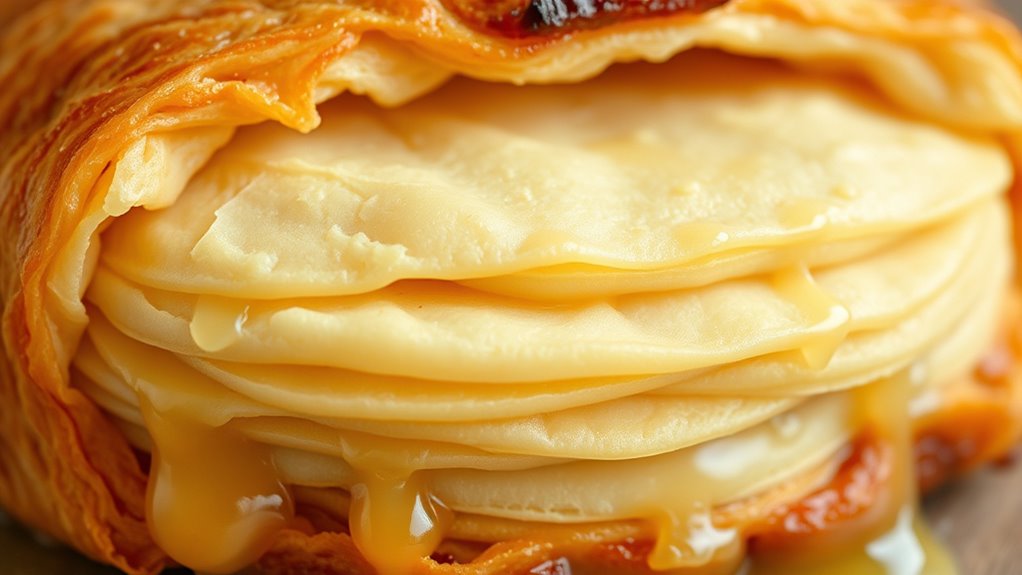
Misjudging the amount of butter used in the layers can cause your Kouign-Amann to collapse or turn out dense. If you use too much butter, the dough becomes overly greasy, which weakens its structure and hampers dough elasticity. This results in a soggy, heavy pastry that doesn’t hold its shape. Conversely, too little butter reduces the rich butter flavor that defines Kouign-Amann and creates thin, fragile layers prone to tearing or collapsing during baking. Properly estimating butter quantity ensures balanced flavor and maintains dough elasticity, giving your layers the strength to expand evenly. Accurate butter measurement also prevents excess moisture, helping your pastry rise properly and retain a flaky, airy texture. Mastering this balance is key to achieving a beautifully layered, perfectly risen Kouign-Amann. Knowing the butter ratio is essential for consistent results and optimal pastry texture.
Failing to Maintain Consistent Temperature Throughout Baking
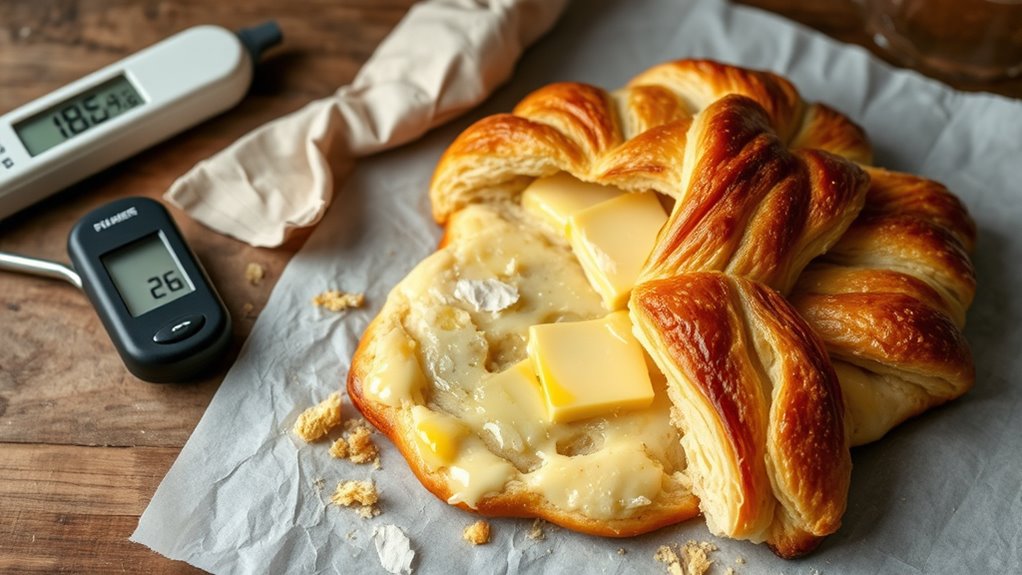
Maintaining a consistent temperature throughout baking is crucial to ensuring your Kouign-Amann rises evenly and develops its characteristic flaky layers. Fluctuations can cause uneven expansion or collapse. Make certain your oven maintains stable heat and appropriate humidity, as oven humidity affects moisture retention in the dough. For example, low humidity can dry out the layers, while high humidity may inhibit browning. Additionally, control your flour’s protein content; higher protein flour develops more gluten, which impacts dough elasticity and oven spring. Use the following table to optimize your baking conditions:
| Temperature Stability | Oven Humidity | Flour Protein Content |
|---|---|---|
| Consistent heat source | Proper humidity level | Select flour with appropriate protein level for desired dough elasticity |
A steady oven temperature and humidity level help ensure your Kouign-Amann achieves the perfect rise and flaky texture.
Frequently Asked Questions
How Does Humidity Affect Butter Consistency During Lamination?
Humidity directly affects butter consistency during lamination by influencing how much it melts and becomes sticky. High humidity causes butter to soften and become more difficult to work with, leading to uneven layers. To prevent this, you need to focus on humidity control, keeping the environment cool and dry. This way, your butter stays firm, making lamination smoother and helping you avoid common issues like collapse or uneven layers.
What Are Signs of Over-Laminated Dough Before Baking?
When you over-laminate dough, you might notice signs like butter melting through the layers, making them greasy and difficult to work with. The dough could tear easily when you try to fold or shape it, indicating it’s become too fragile. These issues show you’ve gone beyond the ideal lamination point, risking a collapsed or dense Kouign-Amann after baking. Keep an eye on these signs to prevent overworking your dough.
Can Alternative Fats Prevent Collapsing in Kouign‑Amann?
You might think butter is the only hero for kouign-amann, but fat substitutions like margarine or vegetable fats can seem tempting. Ironically, these alternatives might prevent collapse by offering more stability, yet they often compromise flakiness and flavor. While butter alternatives can help avoid the dreaded collapse, they usually come at the cost of the pastry’s rich, tender texture. So, choose wisely—sometimes, sticking with butter is the real secret.
How Does Oven Humidity Influence Kouign‑Amann Rise?
Oven humidity plays a key role in your kouign‑amann’s rise by controlling butter melting and dough hydration. High humidity keeps the outer layer moist, allowing steam to build up, which helps the pastry expand better. Too little humidity causes rapid butter melting and dries out the dough, preventing proper rise. By maintaining ideal humidity, you guarantee consistent dough hydration and a beautifully risen, flaky kouign‑amann.
What Tools Help Ensure Even Butter Distribution?
To guarantee even butter distribution, you can use butter spreaders for precise application and smooth layering. Dough dividers help portion the dough evenly, preventing uneven butter placement. These tools allow you to work efficiently, ensuring the butter is spread uniformly throughout the dough. Consistent distribution is key to achieving a perfect kouign‑amann with flaky, tender layers, so investing in these tools can greatly improve your baking results.
Conclusion
To truly elevate your kouign‑amann, pay close attention to each step—sometimes, the smallest adjustments make all the difference. Embrace patience and precision, for perfection often lies in subtle details. When you nurture your dough with care and respect its delicate balance, you’ll find that even unexpected setbacks can become gentle lessons. With a mindful touch, you’ll craft pastries that rise gracefully, revealing the artistry hidden within each buttery layer.
